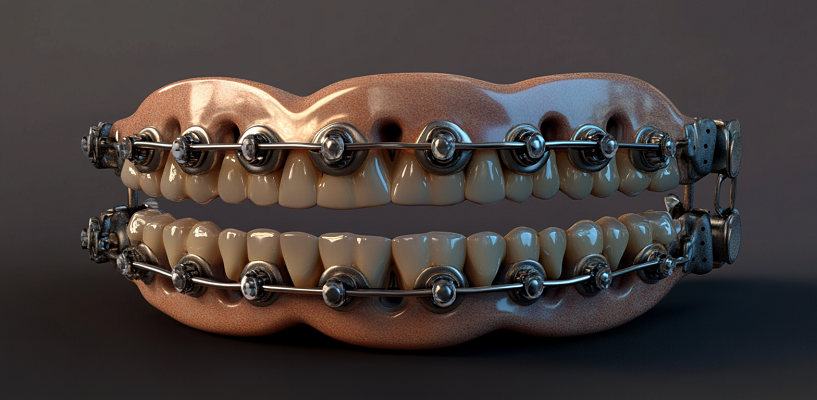How much are braces

| Braces (child) | Braces (adults) |
|---|---|
| $5,842 approx. | $6,496 approx. |
| Children should normally anticipate to wear braces for 12 to 24 months, though this might vary based on the ‘degree of tooth misalignment’ and the ‘type of orthodontic treatment’ chosen. | Adults should normally anticipate to wear braces for 18 to 30 months, though this might vary based on the ‘degree of tooth misalignment’ and the ‘type of orthodontic treatment’ chosen. Treatment duration can also be increased by bone maturation, a decrease in mineral turnover, and patients who do not follow appliances ‘maintenance’ instructions. |
By the age of seven, children should have their ‘first’ orthodontic examination, according to AAO experts. Children have a mixture of ‘baby (primary) and permanent’ teeth at this age, and the orthodontist may learn a lot about them by looking at them.
| Type | Cost Range | Duration of Treatment |
|---|---|---|
| Traditional Braces | $3000 - $5000 | 12-24 months |
| Ceramic Braces | $4000 - $7000 | 12-36 months |
| Lingual Braces | $5000 - $8000 | 18-36 months |
| Aligners | $3,000 - $7,000 | 12-24 months |
| Self-Ligating Braces | $3,000 - $8,000 | 12-24 months |
The American Dental Association’s Dental Fees report, available at “ebusiness.ada.org/Assets/docs/85994.pdf,” is the source of the fees/cost calculation. Current Dental Terminology (CDT) codes: D8000-D8999.
You should see as many different orthodontists is necessary to discover a good “price and payment plan” that fits within your budget, as the majority of them may provide a free consultation. Find an orthodontist near you at “aaoinfo.org/locator/”.
Many orthodontists provide various payment options, such as in-house financing with “monthly payment plans and minimal to zero percent interest,” which makes braces more inexpensive by letting you to stretch out the cost over time.
Orthodontic treatment benefits may be included in ‘dental insurance’ plans, but policy to policy coverage may differ greatly. Insurance usually provides a ‘predetermined’ benefit amount or pays a ‘portion’ of the treatment costs.
Several organizations and charitable programs help “people” (who need orthodontic treatment but cannot afford it) by providing ‘grants or financial assistance.’ For children under the age of 18, AAO offers ‘low- or no-cost’ orthodontic treatment through its Gifted Smiles (“aaoinfo.org/treatments/gifted-smiles/”), Smiles Changes Lives (“smileschangelives.org/”), and Smile for a Lifetime (“smileforalifetime.org/”) programs.
Does CHIP cover braces -
Under the “Children’s Health Insurance Program” (CHIP) program, orthodontics (braces) (CDT codes: D8000-D8999) are covered for dental benefits. Currently, the CHIP program in every state covers some degree of ‘diagnostic and preventive’ dental services. Children who qualify for ‘dental-only supplemental’ services must receive the same dental care as children who qualify for CHIP otherwise.
Go to “medicaid.gov/chip/index.html” for more information on CHIP.
Does FSA cover braces -
You can use the funds from your ‘Health Care FSA’ (HC FSA) or ‘Limited Expense Health Care FSA’ (LEX HCFSA) to cover the cost of braces. Three different FSA categories/options are available through the FSAFEDS: Dependent Care FSA (DC FSA), Limited Expense Health Care FSA (LEX HCFSA), and Health Care FSA (HC FSA).
Employers can provide their employees a tax-favored program called a “Flexible Spending Account” (FSA) that lets them use pre-tax money to pay for qualified out-of-pocket “medical expenses and dependent care costs” that aren’t covered by their health insurance plan.
You are probably qualified to enroll if you work as an active employee for ‘an Executive Branch agency’ or any other federal ‘entity, commission or agency’ that has adopted the “Federal Flexible Spending Account Program” (FSAFEDS).
Go to “fsafeds.gov/explore” for more information on “FSAFEDS and related plans.”
Additionally, you can use these pre-tax monies to pay for braces if you have a “Medical Savings Account (MSA), Health Reimbursement Arrangement (HRA), or Health Savings Account (HSA).” Read out ‘account related’ guidelines/documentation to know the benefits included in your account type/option.
Does FEDVIP cover braces -
Your FEDVIP dental plan can help you pay for braces, and most plans cover about 50% of the cost on average, up to a ‘maximum’ of about $2,500.
In the event that you sign up for the “Federal Employees Dental and Vision Insurance Program” (FEDVIP), orthodontic
services (conventional braces or clear aligners) are based on the ‘option/plan’ you sign up for. Visit “benefeds.gov” to learn more about the “Blue Cross Blue Shield FEP Dental” plan and related plans.
Does TRICARE cover braces -
Braces are not covered by TRICARE; however, you may buy the “TRICARE Dental Program” (TDP) to cover the same. Clear aligners and other orthodontic services (braces, retainers, and casts) are covered by the TDP for 50% of the total cost, until you reach a “Orthodontic Lifetime Maximum” (OLM) of $1,750. You cover the whole cost of care once you’ve reached the OLM.
TDP pays braces’ costs for:
- Sponsors under the age of 23 from the ‘National Guard and Reserve’ (Consult your unit commander prior to receiving braces. Otherwise, you might have to ‘quit active duty’ or ‘pay to have your braces taken off’ if it prevents you from being assigned to specific tasks).
- Spouses of “active-duty members” or ‘sponsors from the National Guard and Reserve,’ who are younger than 23.
- Children under the age of twenty-one, or “under twenty-three if they are full-time students.”
A “Non-Availability and Referral Form” (NARF) is required if you reside abroad in order to receive braces.
Orthodontic services are not covered by the “Active-Duty Dental Program” (ADDP). Braces are part of this. Download the ADDP Handbook from “tricare.mil/-/media/Files/TRICARE/Publications/Handbooks/ADDP_HB.pdf” to find out more.
Go to “tricare.mil/FAQs/General/Gen_Braces” for more information on “TDP and related services” regarding braces.
Braces Types -
Traditional Braces -
Stainless steel (Metal) brackets and wires called “traditional braces” are cemented to the outside of the teeth. Throughout the course of ‘treatment,’ wires are adjusted periodically to gently move teeth into the ideal position.
Ceramic Braces -
Clear brackets called “ceramic braces” are cemented to the outside of the teeth. But compared to metal, ceramic is more brittle. Wires can be of ‘metal or clear’ type. Throughout the course of ‘treatment,’ wires are adjusted periodically to gently move teeth into the ideal position.
Aligners -
Clear, detachable, custom-made tools called “aligners” are used to straighten teeth that are slightly misaligned. Teeth are slowly moved via aligners, which are thin plastic trays. They are a ‘substitute’ for conventional fixed braces and are adjusted/changed on a regular basis to progressively move teeth into the correct alignment. Clear or Invisalign braces are another name for aligners.
Lingual Braces -
Metal brackets and wires called “lingual braces” are cemented to the back of the teeth. Throughout the course of ‘treatment,’ wires are adjusted periodically to gently move teeth into the ideal position.
Self-Ligating Braces -
Self-Ligating braces having brackets with built-in “clips or doors” that hold the wire. These brackets reduce friction and, in most cases, extend the ‘interval’ between checkups/visits. Ceramic or metal can be used to build self-ligating brackets.
Factors affecting the braces cost -
The expense of the materials and the numerous appointments required for “placement, adjustments, and repairs” are the main reasons braces are so expensive. The cost of braces can vary greatly, and your ‘exact’ cost will depend on following factors:
- All-inclusive pricing is something that some orthodontists provide; it includes the price of braces, all appointments (including emergency visits), and ‘retainers after treatment.’ Ask an orthodontist “what is and isn’t included” in the given price when you consult them.
- The overall ‘cost’ of braces can be significantly increased by the number of monthly appointments. Your original tooth ‘position’ dictates how long you need to wear braces, which are typically worn for 24 months on average.
- Talk to your orthodontist about whether ‘each’ suggested procedure is necessary. Certain components of the treatment plan may be ‘changed, merged or put off’ in certain circumstances without materially affecting the final result.
- Smaller towns and cities typically have lower costs for ‘braces and orthodontic care’ than do major cities like “New York, Washington, Los Angeles, etc.”
- You will be responsible for paying for additional appointments to fix any ‘damage’ caused by broken braces brackets. Pay attention to what your orthodontist recommends and “watch what you eat to prevent damage to your braces.”
The official website of “American Association of Orthodontists (AAO)” is: https://aaoinfo.org/.
That’s all friends.
Ads Section

